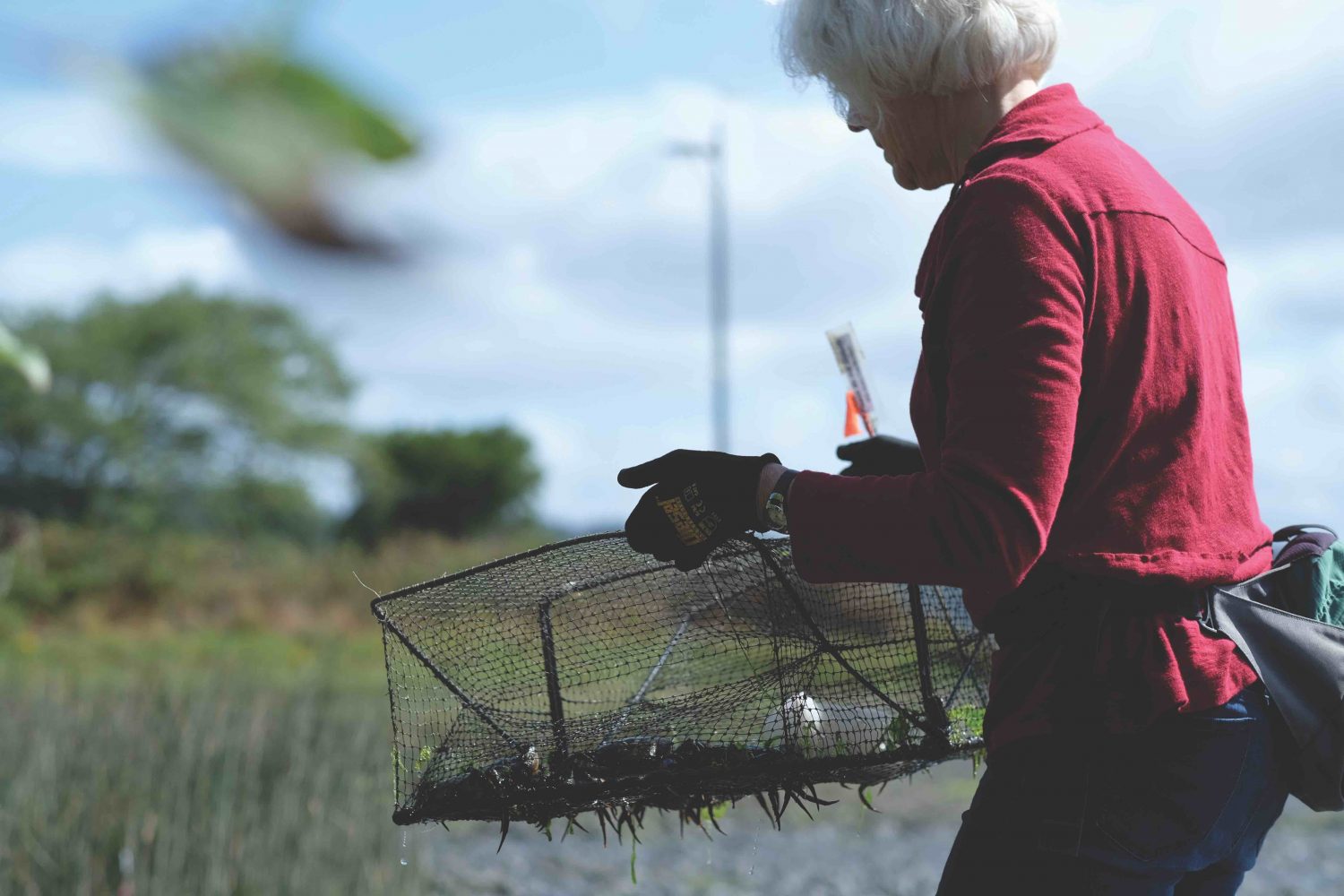By Nick Houtman
You can’t catch European green crabs on the Oregon coast with just any bait. As with native Dungeness and red rock crabs, fish heads and other processing delicacies attract the invasive greens.
Sylvia Yamada prefers to use red “blood line” meat from albacore tuna loins. She gets them from Chuck’s Seafood in Charleston. She stakes baited minnow and Fukui fish traps into mudflats and also deploys coffee cans without bait, so-called pit-fall traps, into which crabs can fall as they forage at high tide. She has experimented with pheromones, chemicals that attract animals for mating and other purposes (they work about as well as tuna but cost more).

Green crabs tolerate warmer, less saline waters than their native cousins and can even survive being dried out. In the deeper waters of Oregon’s estuaries, red rock crabs will prey on the invaders, so Yamada puts her traps in the muddy margins of bays where the greens can thrive.
Yamada, an internationally known expert on these animals, has a courtesy appointment in the Department of Integrative Biology in the College of Science at Oregon State University. For more than 20 years, she has tracked the yearly ups and downs of green crabs in Oregon and Washington. The invaders were relatively rare during most of that time. Since 2015, she and other scientists have seen a surge in their numbers, suggesting that a shift in coastal ecology is underway. Oregon Sea Grant and the Pacific Marine State Fisheries Commission have supported some of Yamada’s efforts, but most of her work has been self-funded.
What she and others are learning illustrates the importance of monitoring and managing nonnative species — and the difficulties of doing so. According to the U.S. Geological Survey, an estimated 28 such species, including plants, fish, crabs and other organisms, have been documented on the Oregon coast. The actual number is likely higher. No one stands regular watch to monitor species in coastal ecosystems.
Sam Chan is the watershed health and aquatic invasive species specialist for Oregon Sea Grant. He says only 3% to 5% of the nation’s estimated 50,000 introduced species cause harm. But it can take decades for them to become established, and if damages do occur, the costs can be significant. Think of pipelines plugged by quagga mussels and lake bottoms covered by zebra mussels (both are native to Eastern Europe), or an isopod parasite from Asia, which is causing the demise of mud shrimp, once one of the most prolific ecological engineers of West Coast estuaries.
Green crabs are known as a voracious predator of clams, oysters and other shellfish and have been shown to be capable of outcompeting commercially valuable Dungeness for habitat and food. Moreover, in experiments, Yamada has shown that the greens are better than Dungeness at crushing and eating native oysters.
The annual tab for managing nonnative species nationwide has been estimated to be over $140 billion, although tracking such costs is an uncertain enterprise. And it doesn’t account for losses, adds Chan, in parks, wetlands, forests and other places where introduced species can dramatically alter landscapes valued for their ecological features.
Northward Bound
European green crabs arrived on the East Coast more than 200 years ago and are now common from New Jersey to the Canadian Maritimes and Newfoundland. The invader has been associated with declines in native crabs, clams and seagrass beds, which they tear up and turn into bare mud in search of food. But it wasn’t until fishermen in San Francisco Bay brought the crabs to scientists’ attention in 1989 that they were documented on the West Coast. Since then, warming waters and ocean currents have carried crab larvae beyond Vancouver Island toward Alaska.
In 1997, fears about the potential impact of green crabs and other nonnatives, such as Chinese mitten crabs and New Zealand mud snails, led the Oregon and Washington Sea Grant programs to jointly form a Marine Invasive Species Team. After a 1998 meeting with shellfish growers, crabbers and state and federal agencies, Yamada detailed what was known about green crabs in a book published by Oregon Sea Grant, Global Invader: The European Green Crab, in 2001.

When she initially learned that green crabs had become abundant in San Francisco Bay, Yamada remembers feeling shocked. “They don’t belong here. In their native habitat, you find them from Morocco and Mauritania to northern Norway and even Iceland,” she says. Globally, the species is now found in Australia, Japan and South Africa as well as South and North America.
Yamada began the regular sampling program that she carries on today, working with scientists at the South Slough National Estuarine Research Reserve and the Oregon Department of Fish and Wildlife. She set out traps from Coos Bay to Yaquina, Netarts, Tillamook and Nehalem in Oregon and Willapa Bay and Gray’s Harbor in Washington.
For the first 15 years or so, she found few of her quarry. For example, in 2003, she placed 1,084 traps in Yaquina Bay and caught 63 green crabs. In 2014, she deployed 147 traps and caught 7 crabs. In some areas she caught none. “Wouldn’t you get discouraged and give up? There were years like that when there was nothing going on,” says Yamada. “But there would be little spikes, usually after a warmer winter.”
That’s because ocean water with temperatures above 10 degrees Centigrade (50 degrees Fahrenheit) is the bottleneck controlling green crab abundance. “Below 10 degrees, you do not get larvae surviving,” she adds. So researchers saw spikes during and immediately after El Nino years, when Pacific Ocean surface temperatures rise and crab larvae could develop and be successfully transported in northbound currents.
In 2015, the sputtering engine of green crab expansion went to full throttle. Yamada and her colleagues have seen green crab numbers steadily increase. “We now have five strong year classes compared to what was there before. 2005 and 2006 (warm years with small spikes in green crab numbers) were nothing like we’re seeing now,” says Yamada. “This year we’re finding a lot of small crabs.”
On mudflats near the Hatfield Marine Science Center in Newport, Yamada’s traps now regularly fill with green crabs. Similar increases have been seen in Coos Bay, according to Shon Schooler, lead scientists with the South Slough Reserve, and in Netarts Bay and Tillamook Bay in Oregon and Makah Bay in Washington.
In 2009, Yamada and her colleagues caught 50 green crabs with 708 traps deployed. In 2018, about the same number of traps yielded 2,305 crabs.

Green crabs have also been found in the Salish Sea between Vancouver Island and the mainland. It’s likely, Yamada and colleagues from Fisheries and Oceans Canada concluded, that they arrived on ocean currents from the south, assisted by persistently warm Pacific Ocean waters during winter storms.
Last summer, green crabs were also found near Bellingham in Washington and beyond Bella Bella north of Vancouver Island. “More locations are popping up all the time,” says Yamada.
Across the Pacific
Nonnatives sometimes benefit from human activity. That was one of the lessons from an analysis of debris rafted across the Pacific after the 2011 Tõhoku earthquake and tsunami in Japan. With a $5 million grant from the Japanese government, researchers evaluated fish, invertebrates, algae and other organisms carried on boats, crates, pieces of plastic and even concrete docks that wound up in Hawaii and along the West Coast. It was the largest such transoceanic crossing of species ever recorded.

In an article in the journal Science in 2017, a team led by James Carlton, a founder of the field of invasive ecology, reported finding that Japanese debris had carried at least 289 living invertebrates and fish species to the West Coast. There was no evidence that any had become established, but about 65% were not known previously in North America. Among the coauthors were Jessica Miller and John Chapman of the OSU Hatfield Marine Science Center as well as scientists at Portland State University and the Oregon Institute of Marine Biology.
An analysis of 84 algal and cyanobacterial species, led by OSU taxonomist Gayle Hansen, also found that none had yet established reproducing populations on the West Coast. Hansen credits quick action by the Oregon Department of Fish and Wildlife, which appears to have prevented most of the species from colonizing the shore.
Nevertheless, continued vigilance, scientists say, will be necessary to avoid surprises in the future. Yamada’s experience tracking green crabs stands as an example of what it takes to keep watch. John Chapman, an OSU marine biologist who has documented the impact of the Asian isopod on mud shrimp, has been inspired by her tenacity. “Sylvia has been out there for years trying to understand what the green crab does and following it to see how it invades. She watched it go up the coast, and here in Yaquina Bay for years and years where it wasn’t abundant. And then she detected the explosion in Yaquina Bay.”
Monitoring a single species is hard enough, but Chapman, Chan, Yamada and other scientists face a more daunting challenge: tracking organisms, whether introduced intentionally or by accident, and working with citizens, businesses and agencies to anticipate and minimize potential threats. Despite the well-known costs of ignoring the issue, such work often faces skepticism if not outright dismissal.
“More introduced species keep arriving,” says Chapman. “A lot of times we don’t even know how that is happening. There are other invaders that spread up the coast but are not tracked at all. People like Sylvia are often treated like they’re peripheral, like they’re collecting stamps or something. I really admire her. She’s one of my heroes.”
Green Crabs on the Menu
One solution to the proliferation of invasive species might be to eat them. Writing in The New Food Economy, writer H. Claire Brown describes a local delicacy in Venice made with green crabs. Caught just after they’ve molted, when their shells are soft, the crabs are soaked in an egg batter, dusted with cornmeal, fried and eaten whole.

